Optimizing Bosch's Supply Chain: The Strategic Role of Warehouses
VerifiedAdded on 2023/06/05
|13
|4050
|272
Report
AI Summary
This report analyzes the supply chain management of Bosch starter motors from Germany to a customer in New Zealand, focusing on the critical role of warehouses. It identifies various types of warehouses used, including private, public, and bonded warehouses, emphasizing the importance of selecting warehouses that ensure product protection and timely delivery. The report also examines key factors in warehouse design, such as operational flow, accessibility, storage space, and throughput, highlighting the need for integration between warehousing and logistics. Management and cost-efficiency issues faced by warehouses are discussed, providing insights into optimizing warehouse operations. Ultimately, the report offers solutions and advice to ensure that Bosch's products reach customers in optimal condition and on schedule, acknowledging the challenges inherent in international supply chains and the necessity of effective and efficient supply chain management.

SUPPLY CHAIN MANAGEMENT 1
Supply chain management
Name of student
Name of institution
Name of instructor
Date
Supply chain management
Name of student
Name of institution
Name of instructor
Date
Paraphrase This Document
Need a fresh take? Get an instant paraphrase of this document with our AI Paraphraser
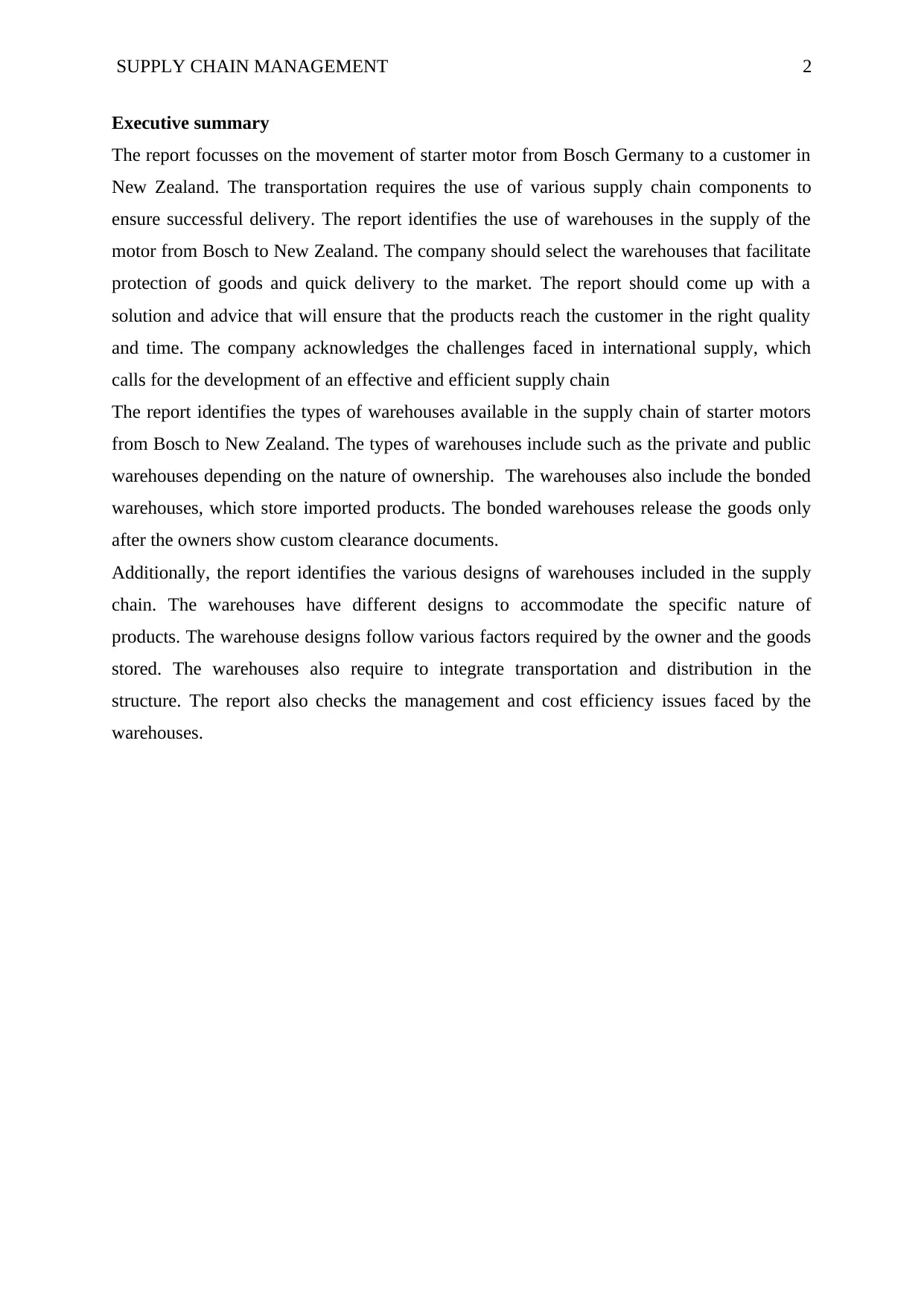
SUPPLY CHAIN MANAGEMENT 2
Executive summary
The report focusses on the movement of starter motor from Bosch Germany to a customer in
New Zealand. The transportation requires the use of various supply chain components to
ensure successful delivery. The report identifies the use of warehouses in the supply of the
motor from Bosch to New Zealand. The company should select the warehouses that facilitate
protection of goods and quick delivery to the market. The report should come up with a
solution and advice that will ensure that the products reach the customer in the right quality
and time. The company acknowledges the challenges faced in international supply, which
calls for the development of an effective and efficient supply chain
The report identifies the types of warehouses available in the supply chain of starter motors
from Bosch to New Zealand. The types of warehouses include such as the private and public
warehouses depending on the nature of ownership. The warehouses also include the bonded
warehouses, which store imported products. The bonded warehouses release the goods only
after the owners show custom clearance documents.
Additionally, the report identifies the various designs of warehouses included in the supply
chain. The warehouses have different designs to accommodate the specific nature of
products. The warehouse designs follow various factors required by the owner and the goods
stored. The warehouses also require to integrate transportation and distribution in the
structure. The report also checks the management and cost efficiency issues faced by the
warehouses.
Executive summary
The report focusses on the movement of starter motor from Bosch Germany to a customer in
New Zealand. The transportation requires the use of various supply chain components to
ensure successful delivery. The report identifies the use of warehouses in the supply of the
motor from Bosch to New Zealand. The company should select the warehouses that facilitate
protection of goods and quick delivery to the market. The report should come up with a
solution and advice that will ensure that the products reach the customer in the right quality
and time. The company acknowledges the challenges faced in international supply, which
calls for the development of an effective and efficient supply chain
The report identifies the types of warehouses available in the supply chain of starter motors
from Bosch to New Zealand. The types of warehouses include such as the private and public
warehouses depending on the nature of ownership. The warehouses also include the bonded
warehouses, which store imported products. The bonded warehouses release the goods only
after the owners show custom clearance documents.
Additionally, the report identifies the various designs of warehouses included in the supply
chain. The warehouses have different designs to accommodate the specific nature of
products. The warehouse designs follow various factors required by the owner and the goods
stored. The warehouses also require to integrate transportation and distribution in the
structure. The report also checks the management and cost efficiency issues faced by the
warehouses.
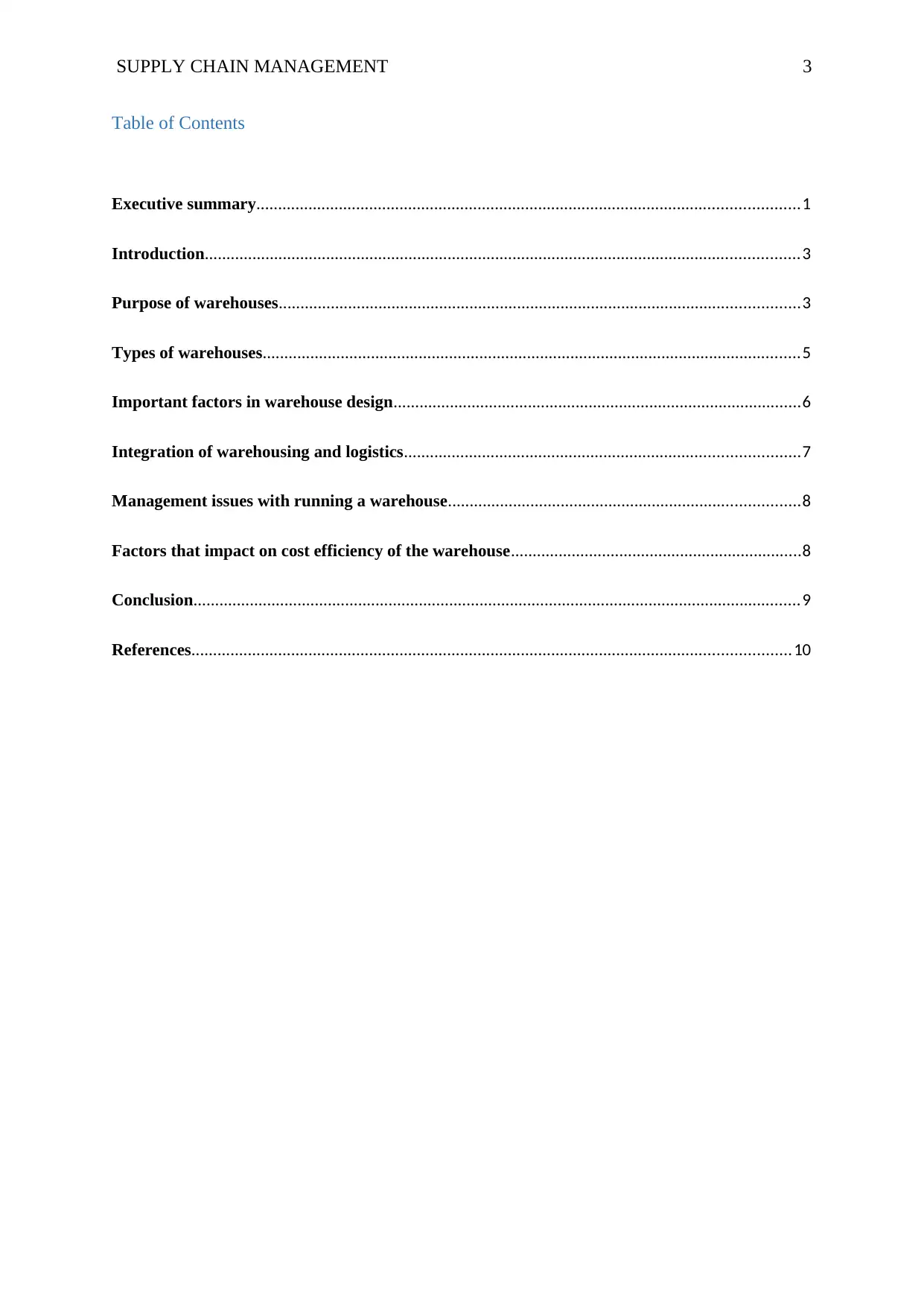
SUPPLY CHAIN MANAGEMENT 3
Table of Contents
Executive summary.............................................................................................................................1
Introduction.........................................................................................................................................3
Purpose of warehouses........................................................................................................................3
Types of warehouses............................................................................................................................5
Important factors in warehouse design..............................................................................................6
Integration of warehousing and logistics...........................................................................................7
Management issues with running a warehouse.................................................................................8
Factors that impact on cost efficiency of the warehouse...................................................................8
Conclusion............................................................................................................................................9
References..........................................................................................................................................10
Table of Contents
Executive summary.............................................................................................................................1
Introduction.........................................................................................................................................3
Purpose of warehouses........................................................................................................................3
Types of warehouses............................................................................................................................5
Important factors in warehouse design..............................................................................................6
Integration of warehousing and logistics...........................................................................................7
Management issues with running a warehouse.................................................................................8
Factors that impact on cost efficiency of the warehouse...................................................................8
Conclusion............................................................................................................................................9
References..........................................................................................................................................10
⊘ This is a preview!⊘
Do you want full access?
Subscribe today to unlock all pages.

Trusted by 1+ million students worldwide
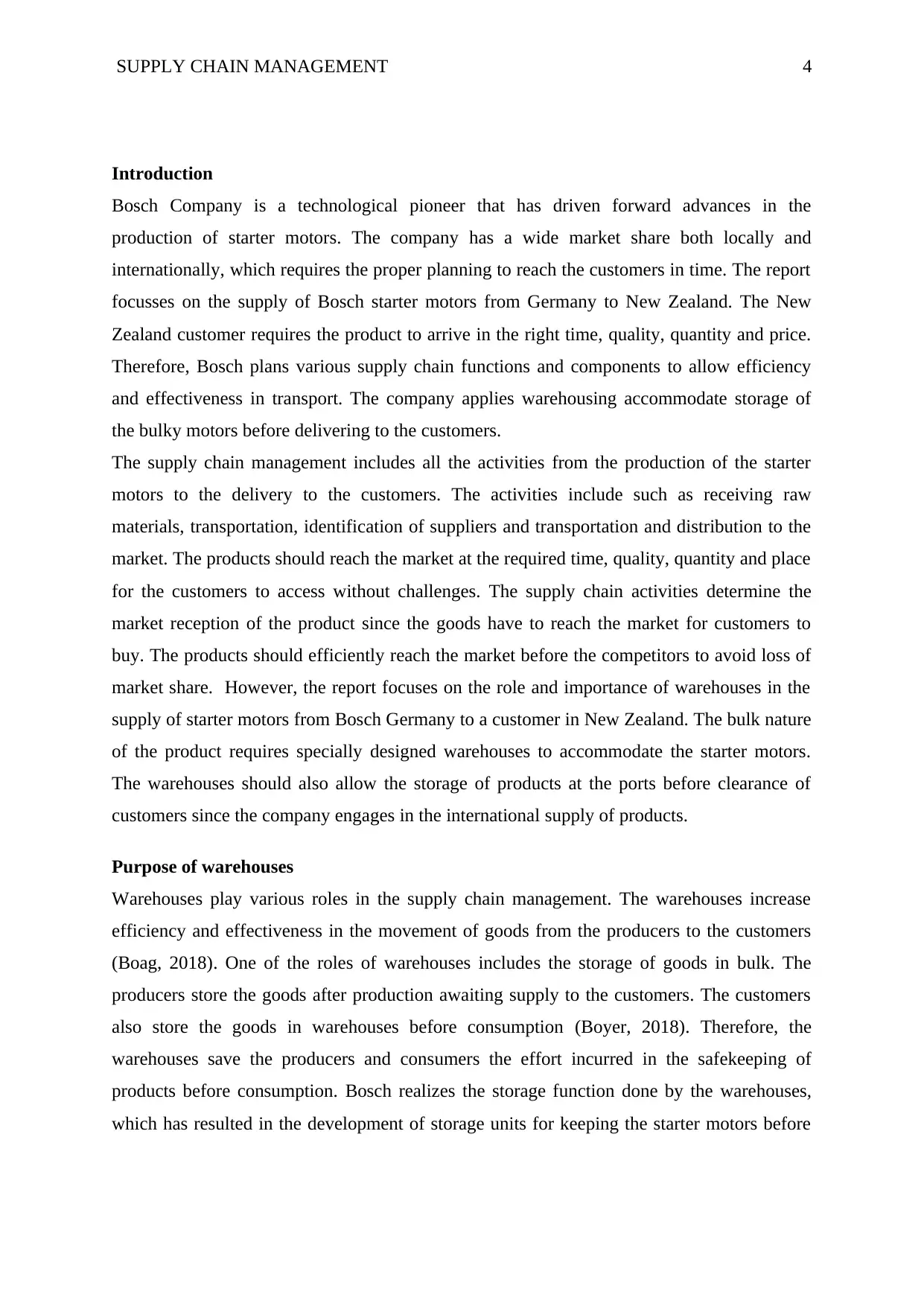
SUPPLY CHAIN MANAGEMENT 4
Introduction
Bosch Company is a technological pioneer that has driven forward advances in the
production of starter motors. The company has a wide market share both locally and
internationally, which requires the proper planning to reach the customers in time. The report
focusses on the supply of Bosch starter motors from Germany to New Zealand. The New
Zealand customer requires the product to arrive in the right time, quality, quantity and price.
Therefore, Bosch plans various supply chain functions and components to allow efficiency
and effectiveness in transport. The company applies warehousing accommodate storage of
the bulky motors before delivering to the customers.
The supply chain management includes all the activities from the production of the starter
motors to the delivery to the customers. The activities include such as receiving raw
materials, transportation, identification of suppliers and transportation and distribution to the
market. The products should reach the market at the required time, quality, quantity and place
for the customers to access without challenges. The supply chain activities determine the
market reception of the product since the goods have to reach the market for customers to
buy. The products should efficiently reach the market before the competitors to avoid loss of
market share. However, the report focuses on the role and importance of warehouses in the
supply of starter motors from Bosch Germany to a customer in New Zealand. The bulk nature
of the product requires specially designed warehouses to accommodate the starter motors.
The warehouses should also allow the storage of products at the ports before clearance of
customers since the company engages in the international supply of products.
Purpose of warehouses
Warehouses play various roles in the supply chain management. The warehouses increase
efficiency and effectiveness in the movement of goods from the producers to the customers
(Boag, 2018). One of the roles of warehouses includes the storage of goods in bulk. The
producers store the goods after production awaiting supply to the customers. The customers
also store the goods in warehouses before consumption (Boyer, 2018). Therefore, the
warehouses save the producers and consumers the effort incurred in the safekeeping of
products before consumption. Bosch realizes the storage function done by the warehouses,
which has resulted in the development of storage units for keeping the starter motors before
Introduction
Bosch Company is a technological pioneer that has driven forward advances in the
production of starter motors. The company has a wide market share both locally and
internationally, which requires the proper planning to reach the customers in time. The report
focusses on the supply of Bosch starter motors from Germany to New Zealand. The New
Zealand customer requires the product to arrive in the right time, quality, quantity and price.
Therefore, Bosch plans various supply chain functions and components to allow efficiency
and effectiveness in transport. The company applies warehousing accommodate storage of
the bulky motors before delivering to the customers.
The supply chain management includes all the activities from the production of the starter
motors to the delivery to the customers. The activities include such as receiving raw
materials, transportation, identification of suppliers and transportation and distribution to the
market. The products should reach the market at the required time, quality, quantity and place
for the customers to access without challenges. The supply chain activities determine the
market reception of the product since the goods have to reach the market for customers to
buy. The products should efficiently reach the market before the competitors to avoid loss of
market share. However, the report focuses on the role and importance of warehouses in the
supply of starter motors from Bosch Germany to a customer in New Zealand. The bulk nature
of the product requires specially designed warehouses to accommodate the starter motors.
The warehouses should also allow the storage of products at the ports before clearance of
customers since the company engages in the international supply of products.
Purpose of warehouses
Warehouses play various roles in the supply chain management. The warehouses increase
efficiency and effectiveness in the movement of goods from the producers to the customers
(Boag, 2018). One of the roles of warehouses includes the storage of goods in bulk. The
producers store the goods after production awaiting supply to the customers. The customers
also store the goods in warehouses before consumption (Boyer, 2018). Therefore, the
warehouses save the producers and consumers the effort incurred in the safekeeping of
products before consumption. Bosch realizes the storage function done by the warehouses,
which has resulted in the development of storage units for keeping the starter motors before
Paraphrase This Document
Need a fresh take? Get an instant paraphrase of this document with our AI Paraphraser
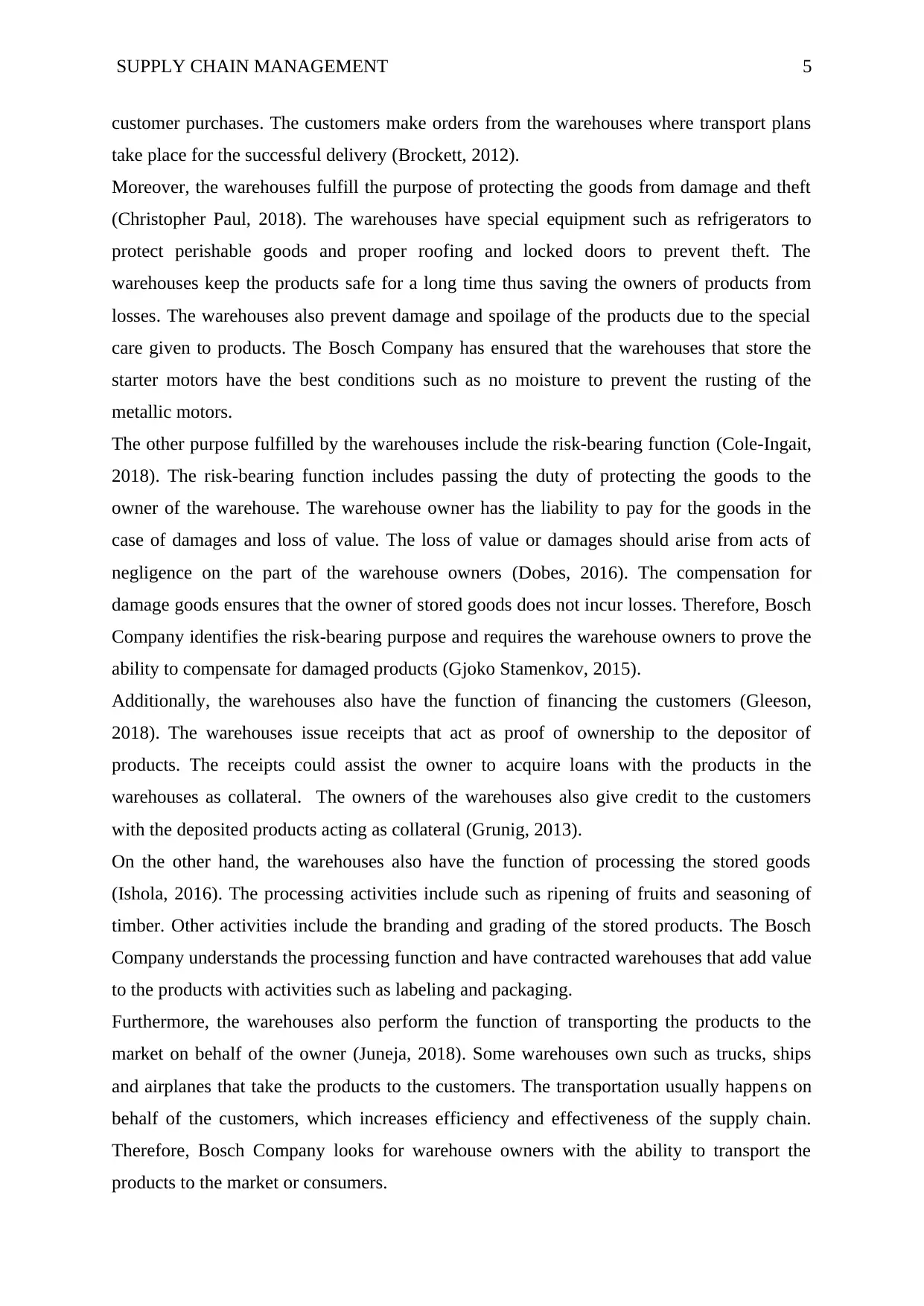
SUPPLY CHAIN MANAGEMENT 5
customer purchases. The customers make orders from the warehouses where transport plans
take place for the successful delivery (Brockett, 2012).
Moreover, the warehouses fulfill the purpose of protecting the goods from damage and theft
(Christopher Paul, 2018). The warehouses have special equipment such as refrigerators to
protect perishable goods and proper roofing and locked doors to prevent theft. The
warehouses keep the products safe for a long time thus saving the owners of products from
losses. The warehouses also prevent damage and spoilage of the products due to the special
care given to products. The Bosch Company has ensured that the warehouses that store the
starter motors have the best conditions such as no moisture to prevent the rusting of the
metallic motors.
The other purpose fulfilled by the warehouses include the risk-bearing function (Cole-Ingait,
2018). The risk-bearing function includes passing the duty of protecting the goods to the
owner of the warehouse. The warehouse owner has the liability to pay for the goods in the
case of damages and loss of value. The loss of value or damages should arise from acts of
negligence on the part of the warehouse owners (Dobes, 2016). The compensation for
damage goods ensures that the owner of stored goods does not incur losses. Therefore, Bosch
Company identifies the risk-bearing purpose and requires the warehouse owners to prove the
ability to compensate for damaged products (Gjoko Stamenkov, 2015).
Additionally, the warehouses also have the function of financing the customers (Gleeson,
2018). The warehouses issue receipts that act as proof of ownership to the depositor of
products. The receipts could assist the owner to acquire loans with the products in the
warehouses as collateral. The owners of the warehouses also give credit to the customers
with the deposited products acting as collateral (Grunig, 2013).
On the other hand, the warehouses also have the function of processing the stored goods
(Ishola, 2016). The processing activities include such as ripening of fruits and seasoning of
timber. Other activities include the branding and grading of the stored products. The Bosch
Company understands the processing function and have contracted warehouses that add value
to the products with activities such as labeling and packaging.
Furthermore, the warehouses also perform the function of transporting the products to the
market on behalf of the owner (Juneja, 2018). Some warehouses own such as trucks, ships
and airplanes that take the products to the customers. The transportation usually happens on
behalf of the customers, which increases efficiency and effectiveness of the supply chain.
Therefore, Bosch Company looks for warehouse owners with the ability to transport the
products to the market or consumers.
customer purchases. The customers make orders from the warehouses where transport plans
take place for the successful delivery (Brockett, 2012).
Moreover, the warehouses fulfill the purpose of protecting the goods from damage and theft
(Christopher Paul, 2018). The warehouses have special equipment such as refrigerators to
protect perishable goods and proper roofing and locked doors to prevent theft. The
warehouses keep the products safe for a long time thus saving the owners of products from
losses. The warehouses also prevent damage and spoilage of the products due to the special
care given to products. The Bosch Company has ensured that the warehouses that store the
starter motors have the best conditions such as no moisture to prevent the rusting of the
metallic motors.
The other purpose fulfilled by the warehouses include the risk-bearing function (Cole-Ingait,
2018). The risk-bearing function includes passing the duty of protecting the goods to the
owner of the warehouse. The warehouse owner has the liability to pay for the goods in the
case of damages and loss of value. The loss of value or damages should arise from acts of
negligence on the part of the warehouse owners (Dobes, 2016). The compensation for
damage goods ensures that the owner of stored goods does not incur losses. Therefore, Bosch
Company identifies the risk-bearing purpose and requires the warehouse owners to prove the
ability to compensate for damaged products (Gjoko Stamenkov, 2015).
Additionally, the warehouses also have the function of financing the customers (Gleeson,
2018). The warehouses issue receipts that act as proof of ownership to the depositor of
products. The receipts could assist the owner to acquire loans with the products in the
warehouses as collateral. The owners of the warehouses also give credit to the customers
with the deposited products acting as collateral (Grunig, 2013).
On the other hand, the warehouses also have the function of processing the stored goods
(Ishola, 2016). The processing activities include such as ripening of fruits and seasoning of
timber. Other activities include the branding and grading of the stored products. The Bosch
Company understands the processing function and have contracted warehouses that add value
to the products with activities such as labeling and packaging.
Furthermore, the warehouses also perform the function of transporting the products to the
market on behalf of the owner (Juneja, 2018). Some warehouses own such as trucks, ships
and airplanes that take the products to the customers. The transportation usually happens on
behalf of the customers, which increases efficiency and effectiveness of the supply chain.
Therefore, Bosch Company looks for warehouse owners with the ability to transport the
products to the market or consumers.
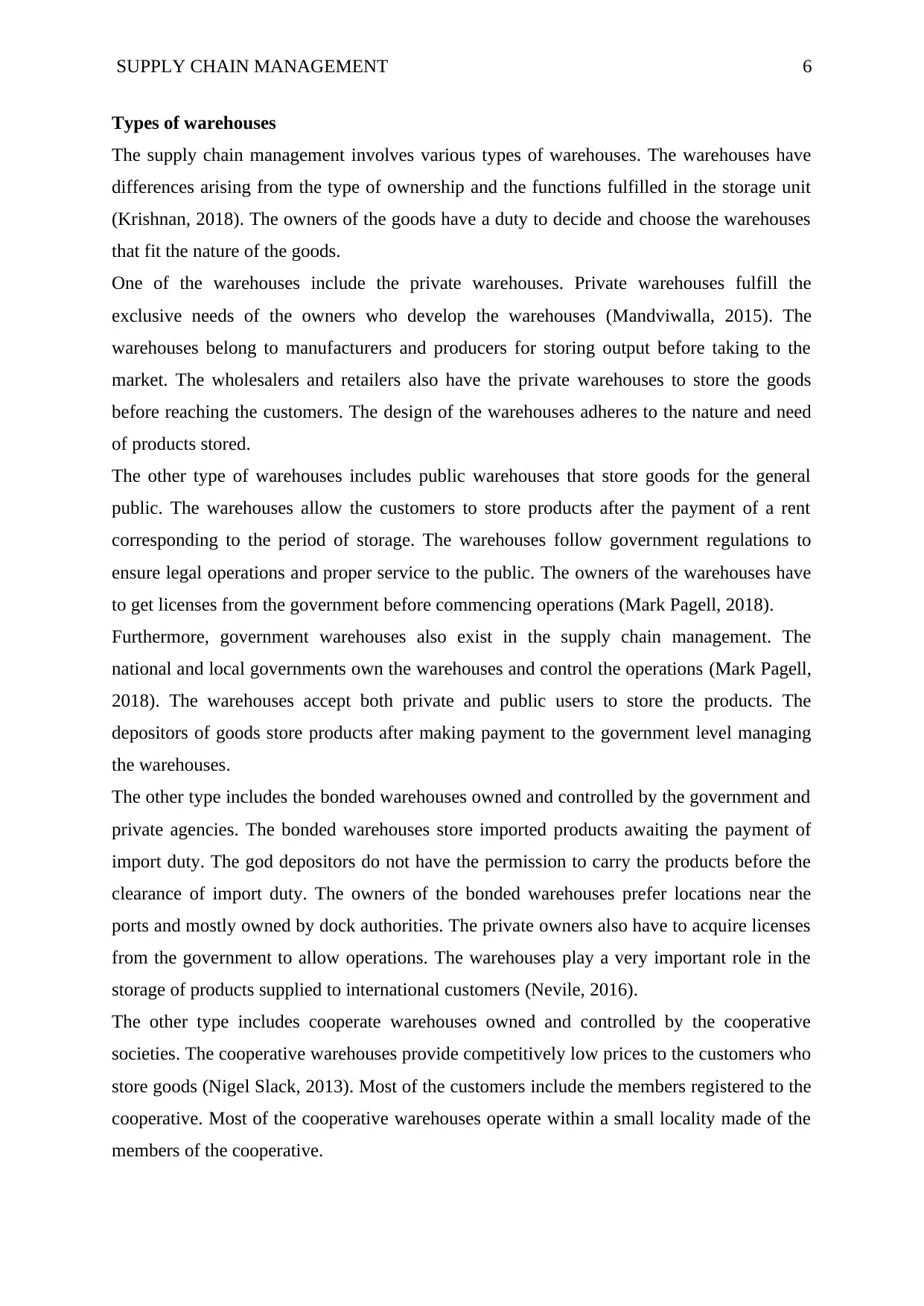
SUPPLY CHAIN MANAGEMENT 6
Types of warehouses
The supply chain management involves various types of warehouses. The warehouses have
differences arising from the type of ownership and the functions fulfilled in the storage unit
(Krishnan, 2018). The owners of the goods have a duty to decide and choose the warehouses
that fit the nature of the goods.
One of the warehouses include the private warehouses. Private warehouses fulfill the
exclusive needs of the owners who develop the warehouses (Mandviwalla, 2015). The
warehouses belong to manufacturers and producers for storing output before taking to the
market. The wholesalers and retailers also have the private warehouses to store the goods
before reaching the customers. The design of the warehouses adheres to the nature and need
of products stored.
The other type of warehouses includes public warehouses that store goods for the general
public. The warehouses allow the customers to store products after the payment of a rent
corresponding to the period of storage. The warehouses follow government regulations to
ensure legal operations and proper service to the public. The owners of the warehouses have
to get licenses from the government before commencing operations (Mark Pagell, 2018).
Furthermore, government warehouses also exist in the supply chain management. The
national and local governments own the warehouses and control the operations (Mark Pagell,
2018). The warehouses accept both private and public users to store the products. The
depositors of goods store products after making payment to the government level managing
the warehouses.
The other type includes the bonded warehouses owned and controlled by the government and
private agencies. The bonded warehouses store imported products awaiting the payment of
import duty. The god depositors do not have the permission to carry the products before the
clearance of import duty. The owners of the bonded warehouses prefer locations near the
ports and mostly owned by dock authorities. The private owners also have to acquire licenses
from the government to allow operations. The warehouses play a very important role in the
storage of products supplied to international customers (Nevile, 2016).
The other type includes cooperate warehouses owned and controlled by the cooperative
societies. The cooperative warehouses provide competitively low prices to the customers who
store goods (Nigel Slack, 2013). Most of the customers include the members registered to the
cooperative. Most of the cooperative warehouses operate within a small locality made of the
members of the cooperative.
Types of warehouses
The supply chain management involves various types of warehouses. The warehouses have
differences arising from the type of ownership and the functions fulfilled in the storage unit
(Krishnan, 2018). The owners of the goods have a duty to decide and choose the warehouses
that fit the nature of the goods.
One of the warehouses include the private warehouses. Private warehouses fulfill the
exclusive needs of the owners who develop the warehouses (Mandviwalla, 2015). The
warehouses belong to manufacturers and producers for storing output before taking to the
market. The wholesalers and retailers also have the private warehouses to store the goods
before reaching the customers. The design of the warehouses adheres to the nature and need
of products stored.
The other type of warehouses includes public warehouses that store goods for the general
public. The warehouses allow the customers to store products after the payment of a rent
corresponding to the period of storage. The warehouses follow government regulations to
ensure legal operations and proper service to the public. The owners of the warehouses have
to get licenses from the government before commencing operations (Mark Pagell, 2018).
Furthermore, government warehouses also exist in the supply chain management. The
national and local governments own the warehouses and control the operations (Mark Pagell,
2018). The warehouses accept both private and public users to store the products. The
depositors of goods store products after making payment to the government level managing
the warehouses.
The other type includes the bonded warehouses owned and controlled by the government and
private agencies. The bonded warehouses store imported products awaiting the payment of
import duty. The god depositors do not have the permission to carry the products before the
clearance of import duty. The owners of the bonded warehouses prefer locations near the
ports and mostly owned by dock authorities. The private owners also have to acquire licenses
from the government to allow operations. The warehouses play a very important role in the
storage of products supplied to international customers (Nevile, 2016).
The other type includes cooperate warehouses owned and controlled by the cooperative
societies. The cooperative warehouses provide competitively low prices to the customers who
store goods (Nigel Slack, 2013). Most of the customers include the members registered to the
cooperative. Most of the cooperative warehouses operate within a small locality made of the
members of the cooperative.
⊘ This is a preview!⊘
Do you want full access?
Subscribe today to unlock all pages.

Trusted by 1+ million students worldwide

SUPPLY CHAIN MANAGEMENT 7
Therefore, Bosch Company should use both the bonded and private warehouses (Olsen,
2018). The private warehouses will allow the company to tailor the storage according to the
requirements of the products. The private warehouses reduce the costs incurred in the storage
of products due to ownership. Additionally, the private warehouses will allow Bosch
Company to store the goods for a long period without expiry of rental duration.
On the other hand, the bonded warehouses allow the company to store the goods sent to
international customers (Perks, 2017). For example, in the case of delivering the starter motor
to the New Zealand customer, the bonded warehouses enable the storage of the products near
the ports awaiting customs clearance.
Important factors in warehouse design
The designing of warehouses requires various considerations to ensure the successful storage
and distribution of the products (Rebecca Stekelorum, 2018). The customers storing goods in
the warehouses check the ability of the warehouse to store the goods in an effective and
efficient manner. One of the factors to consider include the flow of operation in the
warehouse. The flow factor refers to the location of activities close to each other. Therefore,
activities at the warehouses should precede each other closely without wasting time. The flow
of activities should ensure that people and stored products move in a controlled and
uninterrupted manner. The flow also focusses on the awareness of the position of various
items such as the handling and storage equipment. The flow factor ensures smooth flow of
stored goods both while entering and leaving the warehouse.
The other factor to consider includes the accessibility status of the warehouse (Russell R. S.,
2014). The warehouse should allow smooth retrieval of the stored products without having to
move many products. For example, the customers should reach the stored commodity by
easily reaching the pallet. The warehouse could ease the accessibility by providing paths and
proper arrangement of store goods. The warehouse could also offer special batch numbers for
the customers to quickly locate the products during retrieval.
The other warehouse design factor includes the space for storing the products (Simon, 2018).
The warehouse should have large space for operation and the storage of products while
leaving a little space for support actions such as the offices. The warehouse should
accommodate many products stored by the customers. On the other hand, the warehouse
Therefore, Bosch Company should use both the bonded and private warehouses (Olsen,
2018). The private warehouses will allow the company to tailor the storage according to the
requirements of the products. The private warehouses reduce the costs incurred in the storage
of products due to ownership. Additionally, the private warehouses will allow Bosch
Company to store the goods for a long period without expiry of rental duration.
On the other hand, the bonded warehouses allow the company to store the goods sent to
international customers (Perks, 2017). For example, in the case of delivering the starter motor
to the New Zealand customer, the bonded warehouses enable the storage of the products near
the ports awaiting customs clearance.
Important factors in warehouse design
The designing of warehouses requires various considerations to ensure the successful storage
and distribution of the products (Rebecca Stekelorum, 2018). The customers storing goods in
the warehouses check the ability of the warehouse to store the goods in an effective and
efficient manner. One of the factors to consider include the flow of operation in the
warehouse. The flow factor refers to the location of activities close to each other. Therefore,
activities at the warehouses should precede each other closely without wasting time. The flow
of activities should ensure that people and stored products move in a controlled and
uninterrupted manner. The flow also focusses on the awareness of the position of various
items such as the handling and storage equipment. The flow factor ensures smooth flow of
stored goods both while entering and leaving the warehouse.
The other factor to consider includes the accessibility status of the warehouse (Russell R. S.,
2014). The warehouse should allow smooth retrieval of the stored products without having to
move many products. For example, the customers should reach the stored commodity by
easily reaching the pallet. The warehouse could ease the accessibility by providing paths and
proper arrangement of store goods. The warehouse could also offer special batch numbers for
the customers to quickly locate the products during retrieval.
The other warehouse design factor includes the space for storing the products (Simon, 2018).
The warehouse should have large space for operation and the storage of products while
leaving a little space for support actions such as the offices. The warehouse should
accommodate many products stored by the customers. On the other hand, the warehouse
Paraphrase This Document
Need a fresh take? Get an instant paraphrase of this document with our AI Paraphraser
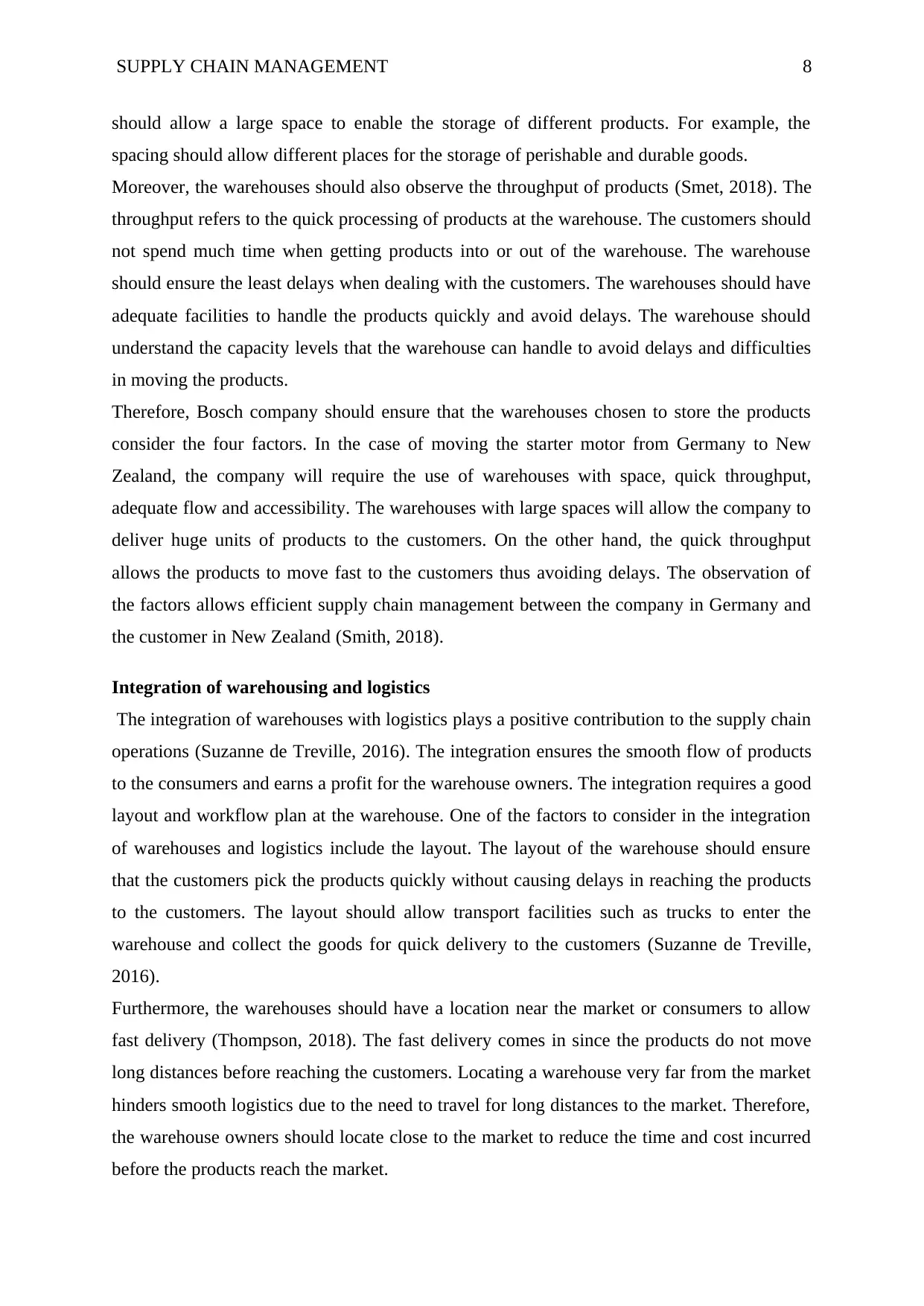
SUPPLY CHAIN MANAGEMENT 8
should allow a large space to enable the storage of different products. For example, the
spacing should allow different places for the storage of perishable and durable goods.
Moreover, the warehouses should also observe the throughput of products (Smet, 2018). The
throughput refers to the quick processing of products at the warehouse. The customers should
not spend much time when getting products into or out of the warehouse. The warehouse
should ensure the least delays when dealing with the customers. The warehouses should have
adequate facilities to handle the products quickly and avoid delays. The warehouse should
understand the capacity levels that the warehouse can handle to avoid delays and difficulties
in moving the products.
Therefore, Bosch company should ensure that the warehouses chosen to store the products
consider the four factors. In the case of moving the starter motor from Germany to New
Zealand, the company will require the use of warehouses with space, quick throughput,
adequate flow and accessibility. The warehouses with large spaces will allow the company to
deliver huge units of products to the customers. On the other hand, the quick throughput
allows the products to move fast to the customers thus avoiding delays. The observation of
the factors allows efficient supply chain management between the company in Germany and
the customer in New Zealand (Smith, 2018).
Integration of warehousing and logistics
The integration of warehouses with logistics plays a positive contribution to the supply chain
operations (Suzanne de Treville, 2016). The integration ensures the smooth flow of products
to the consumers and earns a profit for the warehouse owners. The integration requires a good
layout and workflow plan at the warehouse. One of the factors to consider in the integration
of warehouses and logistics include the layout. The layout of the warehouse should ensure
that the customers pick the products quickly without causing delays in reaching the products
to the customers. The layout should allow transport facilities such as trucks to enter the
warehouse and collect the goods for quick delivery to the customers (Suzanne de Treville,
2016).
Furthermore, the warehouses should have a location near the market or consumers to allow
fast delivery (Thompson, 2018). The fast delivery comes in since the products do not move
long distances before reaching the customers. Locating a warehouse very far from the market
hinders smooth logistics due to the need to travel for long distances to the market. Therefore,
the warehouse owners should locate close to the market to reduce the time and cost incurred
before the products reach the market.
should allow a large space to enable the storage of different products. For example, the
spacing should allow different places for the storage of perishable and durable goods.
Moreover, the warehouses should also observe the throughput of products (Smet, 2018). The
throughput refers to the quick processing of products at the warehouse. The customers should
not spend much time when getting products into or out of the warehouse. The warehouse
should ensure the least delays when dealing with the customers. The warehouses should have
adequate facilities to handle the products quickly and avoid delays. The warehouse should
understand the capacity levels that the warehouse can handle to avoid delays and difficulties
in moving the products.
Therefore, Bosch company should ensure that the warehouses chosen to store the products
consider the four factors. In the case of moving the starter motor from Germany to New
Zealand, the company will require the use of warehouses with space, quick throughput,
adequate flow and accessibility. The warehouses with large spaces will allow the company to
deliver huge units of products to the customers. On the other hand, the quick throughput
allows the products to move fast to the customers thus avoiding delays. The observation of
the factors allows efficient supply chain management between the company in Germany and
the customer in New Zealand (Smith, 2018).
Integration of warehousing and logistics
The integration of warehouses with logistics plays a positive contribution to the supply chain
operations (Suzanne de Treville, 2016). The integration ensures the smooth flow of products
to the consumers and earns a profit for the warehouse owners. The integration requires a good
layout and workflow plan at the warehouse. One of the factors to consider in the integration
of warehouses and logistics include the layout. The layout of the warehouse should ensure
that the customers pick the products quickly without causing delays in reaching the products
to the customers. The layout should allow transport facilities such as trucks to enter the
warehouse and collect the goods for quick delivery to the customers (Suzanne de Treville,
2016).
Furthermore, the warehouses should have a location near the market or consumers to allow
fast delivery (Thompson, 2018). The fast delivery comes in since the products do not move
long distances before reaching the customers. Locating a warehouse very far from the market
hinders smooth logistics due to the need to travel for long distances to the market. Therefore,
the warehouse owners should locate close to the market to reduce the time and cost incurred
before the products reach the market.
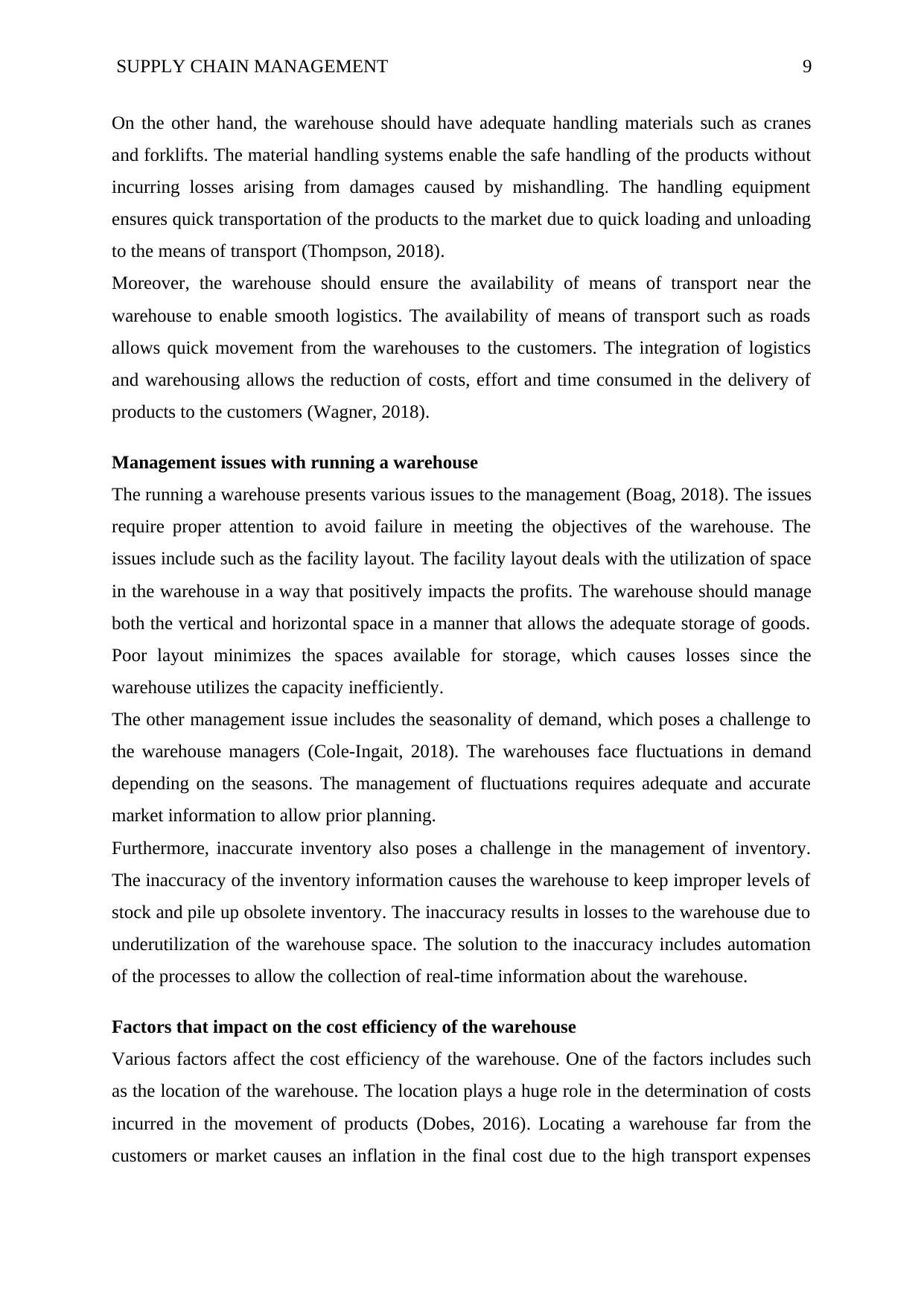
SUPPLY CHAIN MANAGEMENT 9
On the other hand, the warehouse should have adequate handling materials such as cranes
and forklifts. The material handling systems enable the safe handling of the products without
incurring losses arising from damages caused by mishandling. The handling equipment
ensures quick transportation of the products to the market due to quick loading and unloading
to the means of transport (Thompson, 2018).
Moreover, the warehouse should ensure the availability of means of transport near the
warehouse to enable smooth logistics. The availability of means of transport such as roads
allows quick movement from the warehouses to the customers. The integration of logistics
and warehousing allows the reduction of costs, effort and time consumed in the delivery of
products to the customers (Wagner, 2018).
Management issues with running a warehouse
The running a warehouse presents various issues to the management (Boag, 2018). The issues
require proper attention to avoid failure in meeting the objectives of the warehouse. The
issues include such as the facility layout. The facility layout deals with the utilization of space
in the warehouse in a way that positively impacts the profits. The warehouse should manage
both the vertical and horizontal space in a manner that allows the adequate storage of goods.
Poor layout minimizes the spaces available for storage, which causes losses since the
warehouse utilizes the capacity inefficiently.
The other management issue includes the seasonality of demand, which poses a challenge to
the warehouse managers (Cole-Ingait, 2018). The warehouses face fluctuations in demand
depending on the seasons. The management of fluctuations requires adequate and accurate
market information to allow prior planning.
Furthermore, inaccurate inventory also poses a challenge in the management of inventory.
The inaccuracy of the inventory information causes the warehouse to keep improper levels of
stock and pile up obsolete inventory. The inaccuracy results in losses to the warehouse due to
underutilization of the warehouse space. The solution to the inaccuracy includes automation
of the processes to allow the collection of real-time information about the warehouse.
Factors that impact on the cost efficiency of the warehouse
Various factors affect the cost efficiency of the warehouse. One of the factors includes such
as the location of the warehouse. The location plays a huge role in the determination of costs
incurred in the movement of products (Dobes, 2016). Locating a warehouse far from the
customers or market causes an inflation in the final cost due to the high transport expenses
On the other hand, the warehouse should have adequate handling materials such as cranes
and forklifts. The material handling systems enable the safe handling of the products without
incurring losses arising from damages caused by mishandling. The handling equipment
ensures quick transportation of the products to the market due to quick loading and unloading
to the means of transport (Thompson, 2018).
Moreover, the warehouse should ensure the availability of means of transport near the
warehouse to enable smooth logistics. The availability of means of transport such as roads
allows quick movement from the warehouses to the customers. The integration of logistics
and warehousing allows the reduction of costs, effort and time consumed in the delivery of
products to the customers (Wagner, 2018).
Management issues with running a warehouse
The running a warehouse presents various issues to the management (Boag, 2018). The issues
require proper attention to avoid failure in meeting the objectives of the warehouse. The
issues include such as the facility layout. The facility layout deals with the utilization of space
in the warehouse in a way that positively impacts the profits. The warehouse should manage
both the vertical and horizontal space in a manner that allows the adequate storage of goods.
Poor layout minimizes the spaces available for storage, which causes losses since the
warehouse utilizes the capacity inefficiently.
The other management issue includes the seasonality of demand, which poses a challenge to
the warehouse managers (Cole-Ingait, 2018). The warehouses face fluctuations in demand
depending on the seasons. The management of fluctuations requires adequate and accurate
market information to allow prior planning.
Furthermore, inaccurate inventory also poses a challenge in the management of inventory.
The inaccuracy of the inventory information causes the warehouse to keep improper levels of
stock and pile up obsolete inventory. The inaccuracy results in losses to the warehouse due to
underutilization of the warehouse space. The solution to the inaccuracy includes automation
of the processes to allow the collection of real-time information about the warehouse.
Factors that impact on the cost efficiency of the warehouse
Various factors affect the cost efficiency of the warehouse. One of the factors includes such
as the location of the warehouse. The location plays a huge role in the determination of costs
incurred in the movement of products (Dobes, 2016). Locating a warehouse far from the
customers or market causes an inflation in the final cost due to the high transport expenses
⊘ This is a preview!⊘
Do you want full access?
Subscribe today to unlock all pages.

Trusted by 1+ million students worldwide
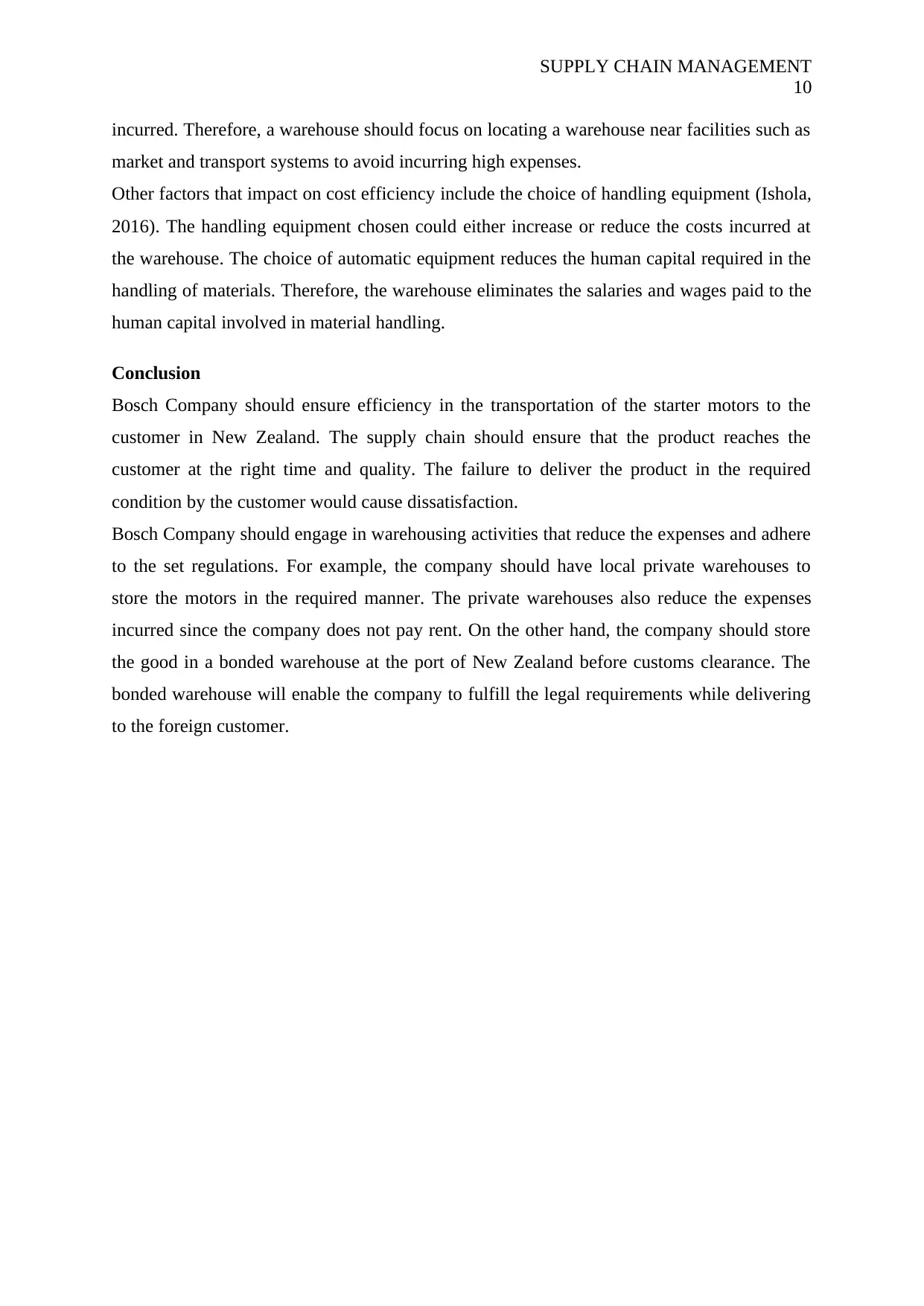
SUPPLY CHAIN MANAGEMENT
10
incurred. Therefore, a warehouse should focus on locating a warehouse near facilities such as
market and transport systems to avoid incurring high expenses.
Other factors that impact on cost efficiency include the choice of handling equipment (Ishola,
2016). The handling equipment chosen could either increase or reduce the costs incurred at
the warehouse. The choice of automatic equipment reduces the human capital required in the
handling of materials. Therefore, the warehouse eliminates the salaries and wages paid to the
human capital involved in material handling.
Conclusion
Bosch Company should ensure efficiency in the transportation of the starter motors to the
customer in New Zealand. The supply chain should ensure that the product reaches the
customer at the right time and quality. The failure to deliver the product in the required
condition by the customer would cause dissatisfaction.
Bosch Company should engage in warehousing activities that reduce the expenses and adhere
to the set regulations. For example, the company should have local private warehouses to
store the motors in the required manner. The private warehouses also reduce the expenses
incurred since the company does not pay rent. On the other hand, the company should store
the good in a bonded warehouse at the port of New Zealand before customs clearance. The
bonded warehouse will enable the company to fulfill the legal requirements while delivering
to the foreign customer.
10
incurred. Therefore, a warehouse should focus on locating a warehouse near facilities such as
market and transport systems to avoid incurring high expenses.
Other factors that impact on cost efficiency include the choice of handling equipment (Ishola,
2016). The handling equipment chosen could either increase or reduce the costs incurred at
the warehouse. The choice of automatic equipment reduces the human capital required in the
handling of materials. Therefore, the warehouse eliminates the salaries and wages paid to the
human capital involved in material handling.
Conclusion
Bosch Company should ensure efficiency in the transportation of the starter motors to the
customer in New Zealand. The supply chain should ensure that the product reaches the
customer at the right time and quality. The failure to deliver the product in the required
condition by the customer would cause dissatisfaction.
Bosch Company should engage in warehousing activities that reduce the expenses and adhere
to the set regulations. For example, the company should have local private warehouses to
store the motors in the required manner. The private warehouses also reduce the expenses
incurred since the company does not pay rent. On the other hand, the company should store
the good in a bonded warehouse at the port of New Zealand before customs clearance. The
bonded warehouse will enable the company to fulfill the legal requirements while delivering
to the foreign customer.
Paraphrase This Document
Need a fresh take? Get an instant paraphrase of this document with our AI Paraphraser
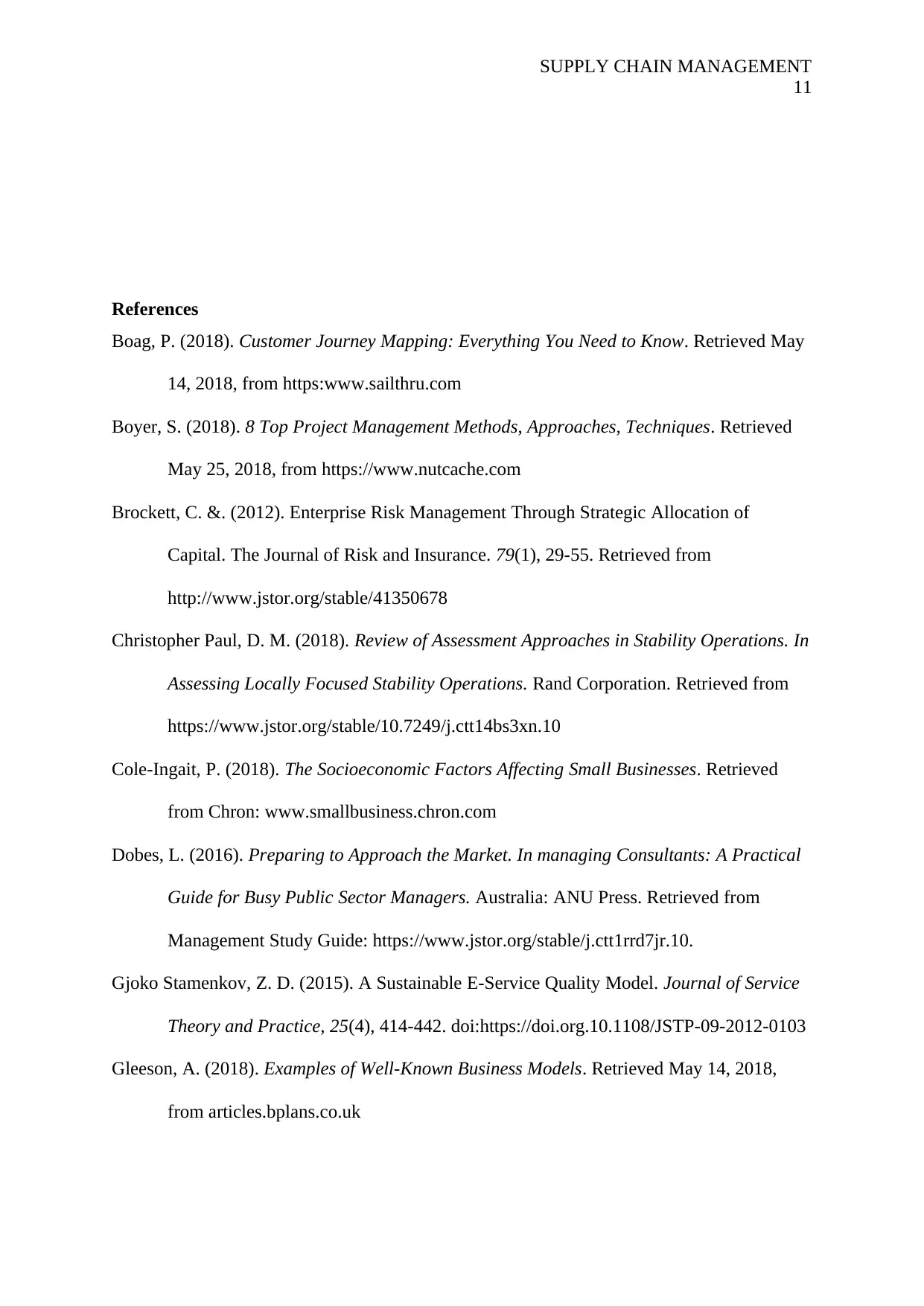
SUPPLY CHAIN MANAGEMENT
11
References
Boag, P. (2018). Customer Journey Mapping: Everything You Need to Know. Retrieved May
14, 2018, from https:www.sailthru.com
Boyer, S. (2018). 8 Top Project Management Methods, Approaches, Techniques. Retrieved
May 25, 2018, from https://www.nutcache.com
Brockett, C. &. (2012). Enterprise Risk Management Through Strategic Allocation of
Capital. The Journal of Risk and Insurance. 79(1), 29-55. Retrieved from
http://www.jstor.org/stable/41350678
Christopher Paul, D. M. (2018). Review of Assessment Approaches in Stability Operations. In
Assessing Locally Focused Stability Operations. Rand Corporation. Retrieved from
https://www.jstor.org/stable/10.7249/j.ctt14bs3xn.10
Cole-Ingait, P. (2018). The Socioeconomic Factors Affecting Small Businesses. Retrieved
from Chron: www.smallbusiness.chron.com
Dobes, L. (2016). Preparing to Approach the Market. In managing Consultants: A Practical
Guide for Busy Public Sector Managers. Australia: ANU Press. Retrieved from
Management Study Guide: https://www.jstor.org/stable/j.ctt1rrd7jr.10.
Gjoko Stamenkov, Z. D. (2015). A Sustainable E-Service Quality Model. Journal of Service
Theory and Practice, 25(4), 414-442. doi:https://doi.org.10.1108/JSTP-09-2012-0103
Gleeson, A. (2018). Examples of Well-Known Business Models. Retrieved May 14, 2018,
from articles.bplans.co.uk
11
References
Boag, P. (2018). Customer Journey Mapping: Everything You Need to Know. Retrieved May
14, 2018, from https:www.sailthru.com
Boyer, S. (2018). 8 Top Project Management Methods, Approaches, Techniques. Retrieved
May 25, 2018, from https://www.nutcache.com
Brockett, C. &. (2012). Enterprise Risk Management Through Strategic Allocation of
Capital. The Journal of Risk and Insurance. 79(1), 29-55. Retrieved from
http://www.jstor.org/stable/41350678
Christopher Paul, D. M. (2018). Review of Assessment Approaches in Stability Operations. In
Assessing Locally Focused Stability Operations. Rand Corporation. Retrieved from
https://www.jstor.org/stable/10.7249/j.ctt14bs3xn.10
Cole-Ingait, P. (2018). The Socioeconomic Factors Affecting Small Businesses. Retrieved
from Chron: www.smallbusiness.chron.com
Dobes, L. (2016). Preparing to Approach the Market. In managing Consultants: A Practical
Guide for Busy Public Sector Managers. Australia: ANU Press. Retrieved from
Management Study Guide: https://www.jstor.org/stable/j.ctt1rrd7jr.10.
Gjoko Stamenkov, Z. D. (2015). A Sustainable E-Service Quality Model. Journal of Service
Theory and Practice, 25(4), 414-442. doi:https://doi.org.10.1108/JSTP-09-2012-0103
Gleeson, A. (2018). Examples of Well-Known Business Models. Retrieved May 14, 2018,
from articles.bplans.co.uk
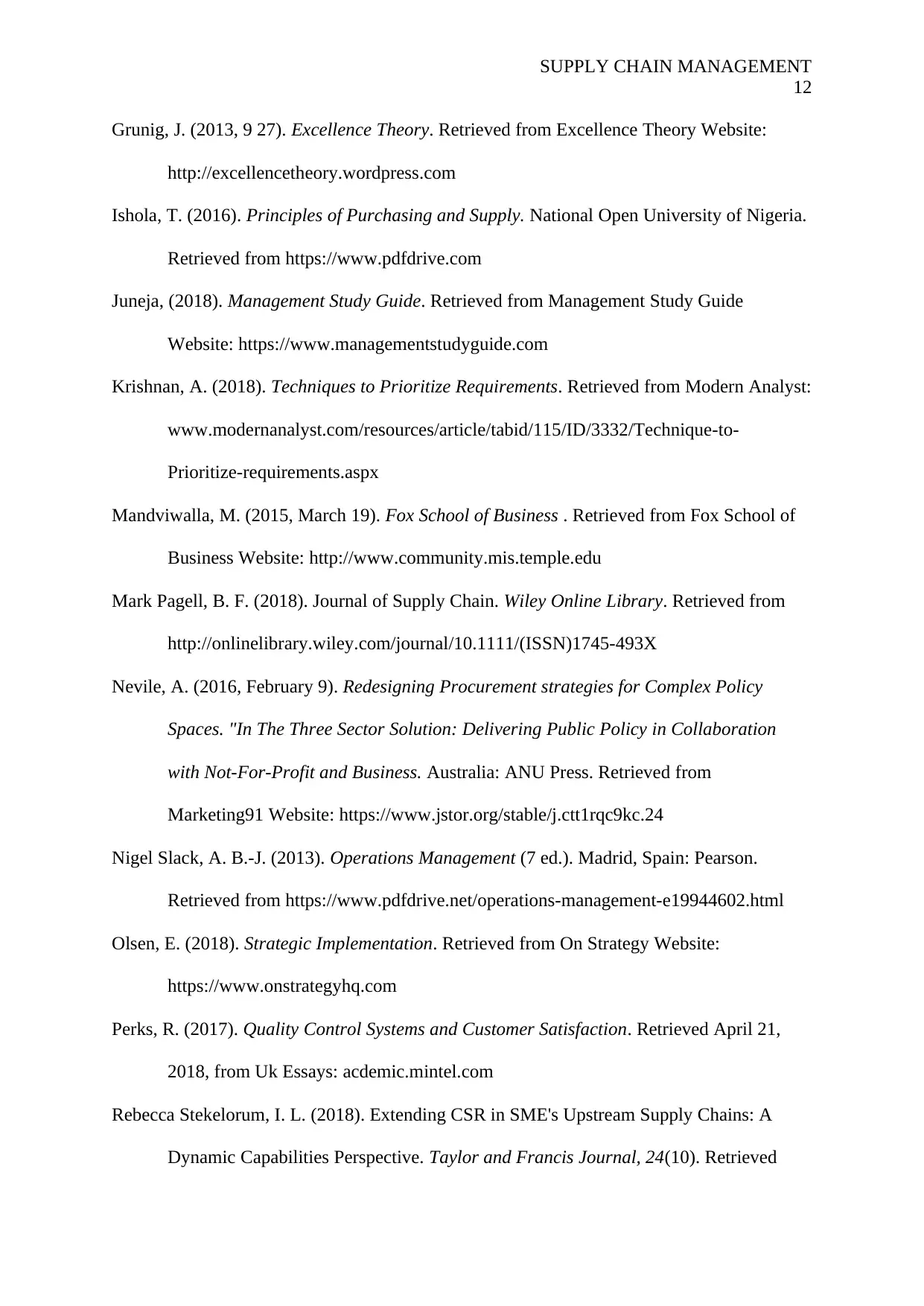
SUPPLY CHAIN MANAGEMENT
12
Grunig, J. (2013, 9 27). Excellence Theory. Retrieved from Excellence Theory Website:
http://excellencetheory.wordpress.com
Ishola, T. (2016). Principles of Purchasing and Supply. National Open University of Nigeria.
Retrieved from https://www.pdfdrive.com
Juneja, (2018). Management Study Guide. Retrieved from Management Study Guide
Website: https://www.managementstudyguide.com
Krishnan, A. (2018). Techniques to Prioritize Requirements. Retrieved from Modern Analyst:
www.modernanalyst.com/resources/article/tabid/115/ID/3332/Technique-to-
Prioritize-requirements.aspx
Mandviwalla, M. (2015, March 19). Fox School of Business . Retrieved from Fox School of
Business Website: http://www.community.mis.temple.edu
Mark Pagell, B. F. (2018). Journal of Supply Chain. Wiley Online Library. Retrieved from
http://onlinelibrary.wiley.com/journal/10.1111/(ISSN)1745-493X
Nevile, A. (2016, February 9). Redesigning Procurement strategies for Complex Policy
Spaces. "In The Three Sector Solution: Delivering Public Policy in Collaboration
with Not-For-Profit and Business. Australia: ANU Press. Retrieved from
Marketing91 Website: https://www.jstor.org/stable/j.ctt1rqc9kc.24
Nigel Slack, A. B.-J. (2013). Operations Management (7 ed.). Madrid, Spain: Pearson.
Retrieved from https://www.pdfdrive.net/operations-management-e19944602.html
Olsen, E. (2018). Strategic Implementation. Retrieved from On Strategy Website:
https://www.onstrategyhq.com
Perks, R. (2017). Quality Control Systems and Customer Satisfaction. Retrieved April 21,
2018, from Uk Essays: acdemic.mintel.com
Rebecca Stekelorum, I. L. (2018). Extending CSR in SME's Upstream Supply Chains: A
Dynamic Capabilities Perspective. Taylor and Francis Journal, 24(10). Retrieved
12
Grunig, J. (2013, 9 27). Excellence Theory. Retrieved from Excellence Theory Website:
http://excellencetheory.wordpress.com
Ishola, T. (2016). Principles of Purchasing and Supply. National Open University of Nigeria.
Retrieved from https://www.pdfdrive.com
Juneja, (2018). Management Study Guide. Retrieved from Management Study Guide
Website: https://www.managementstudyguide.com
Krishnan, A. (2018). Techniques to Prioritize Requirements. Retrieved from Modern Analyst:
www.modernanalyst.com/resources/article/tabid/115/ID/3332/Technique-to-
Prioritize-requirements.aspx
Mandviwalla, M. (2015, March 19). Fox School of Business . Retrieved from Fox School of
Business Website: http://www.community.mis.temple.edu
Mark Pagell, B. F. (2018). Journal of Supply Chain. Wiley Online Library. Retrieved from
http://onlinelibrary.wiley.com/journal/10.1111/(ISSN)1745-493X
Nevile, A. (2016, February 9). Redesigning Procurement strategies for Complex Policy
Spaces. "In The Three Sector Solution: Delivering Public Policy in Collaboration
with Not-For-Profit and Business. Australia: ANU Press. Retrieved from
Marketing91 Website: https://www.jstor.org/stable/j.ctt1rqc9kc.24
Nigel Slack, A. B.-J. (2013). Operations Management (7 ed.). Madrid, Spain: Pearson.
Retrieved from https://www.pdfdrive.net/operations-management-e19944602.html
Olsen, E. (2018). Strategic Implementation. Retrieved from On Strategy Website:
https://www.onstrategyhq.com
Perks, R. (2017). Quality Control Systems and Customer Satisfaction. Retrieved April 21,
2018, from Uk Essays: acdemic.mintel.com
Rebecca Stekelorum, I. L. (2018). Extending CSR in SME's Upstream Supply Chains: A
Dynamic Capabilities Perspective. Taylor and Francis Journal, 24(10). Retrieved
⊘ This is a preview!⊘
Do you want full access?
Subscribe today to unlock all pages.

Trusted by 1+ million students worldwide
1 out of 13
Related Documents
Your All-in-One AI-Powered Toolkit for Academic Success.
+13062052269
info@desklib.com
Available 24*7 on WhatsApp / Email
![[object Object]](/_next/static/media/star-bottom.7253800d.svg)
Unlock your academic potential
Copyright © 2020–2026 A2Z Services. All Rights Reserved. Developed and managed by ZUCOL.




